John Inglis (Royal Navy officer)

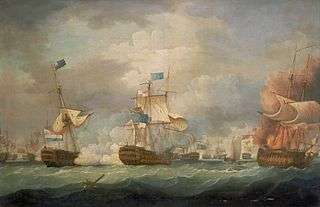
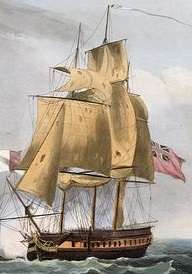
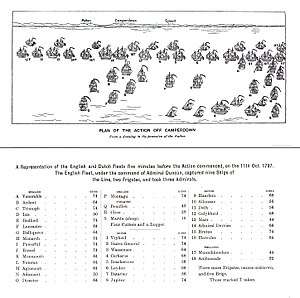
Vice Admiral John Inglis of Auchendinny and Redhall RN (1743–1807) was an 18th century Scottish Royal Navy officer who served with distinction at the Battle of Camperdown in 1797.
Life
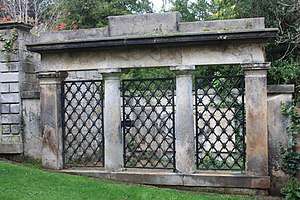
He was born on 20 March 1743 in Philadelphia, the eldest son of John Inglis, a Scottish merchant settled in America, and his wife, Catherine McCall. He was baptised (somewhat tardily) in September 1744 at Christ Church, Philadelphia.[1]
In 1757, during the Seven Years' War, he joined HMS Garland as a volunteer. However, after heavy weather, he was recorded as a runaway. This did not discourage him from rejoining.
In 1758 he entered the colonial section of the Royal Navy serving on the newly built HMS Hussar under Captain John Elliot. Elliot's brother, Andrew, was married to John's aunt, Eleanor McCall. John was promoted to Lieutenant in 1761 and in 1768 he was given his first charge on the newly built HMS Sultana (a small 8-gunner).[2]
He absented himself from America during the American War of Independence, but returned in April 1778 on board HMS Trident, an impressive 64-gunner, now in the role of Commander. In June he moved to the smaller HMS Senegal. Unfortunately his ship was captured by the French fleet under the Comte d'Estaing during the Rhode Island campaign in August 1778. In the spring of 1779 he was given command of the newly-built 14-gunner HMS Delight which he sailed to North America in June. Here he captured the US ships Industry (18 February) and Macaroni (16 April). He then joined the larger ship HMS Blonde under Cpt Andrew Barkley setting off from Charlestown to clear the Cape Fear River of American ships in January 1781.[3]
In August 1781 he was promoted to Captain and Commander and given HMS Squirrel a 20-gunner from the mid 18th century. This was dispatched to fight the French, capturing the Furet on 15 February 1782 and the 8-gunner Aimable Manon on 21 June 1782. The Squirrel was sold off soon after and Inglis went into a period of inactivity.
In 1783 he was living in Philadelphia. He returned to Scotland when he inherited various estates (through his marriage to his cousin) from an uncle, George Inglis of Auchendinny: Auchendinny House near Penicuik and Redhall House near Edinburgh (which George had built in 1758).[4]
In 1793 he was one of the jury in the trial of Thomas Muir of Huntershill, one of the most important cases in Scottish legal history.He returned to active service in the navy in 1795.[5] He was then given charge of the highly impressive new ship HMS Coromandel a 56-gunner including 28 new carronades.
In May 1796 he took command of HMS Belliqueux. This 64-gunner was involved in quelling the mutiny of the Plymouth Squadron in the North Sea later that month and the mutiny at Nore.
His crowning glory (still commanding Belliqueux, as on 11 October 1797 at the Battle of Camperdown under the overall command of Admiral Adam Duncan. Not fully obeying orders he sailed into the main affray from his original position to the rear. There his crew suffered 25 killed and 78 injured, the second highest in the British fleet on that day. Although not injured he took a break from active service for 12 months (being replaced by Cpt Henry Inman. Inman was in turn replaced by Cpt Robert England before Inglis resumed command in October 1798. However he left the ship in May 1799. On 1 January 1801 he was promoted to Rear Admiral and to Vice Admiral on 11 March 1807.
He died at Redhall on 17 March 1807. He is buried in a vault on the north side of Colinton Parish Church.
Family
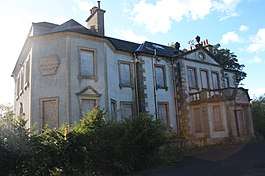
In January 1777 he married his cousin Barbara Inglis of Auchendinny (d.1820).[6] They had at least two daughters and three sons.
His eldest son John Inglis (1783-1847) became an advocate in Edinburgh. John married Robert Johnstone Brown (sic) then Maria Monro, daughter of Alexander Monro (tertius). Their son Dr Alexander Inglis (1853-1897) was father to John Alexander Inglis.
Their second son George Inglis (1788-1849) served as a Lieutenant in the Royal Navy.[7]
His eldest daughter Jane Inglis married the naval hero Cpt James Coutts Crawford. They in turn were parents to Coutts Crawford.
Family Tree
| John Inglis family tree | ||||||||||||||||||||||||||||||||||||||||||||||||||||||||||||||||||||||||||||||||||||||||||||||||||||||||||||||||||||||||||||||||||||||||||||||||||||||||||||||||||||||||||||||||||||||||||||||||||||||||||||||||||||||||||||||||||||||||||||||||||||||||||||||||||||||||||||||||||||||||||||||||||||||||||||||||||||||||||||||||||||||||||||||||||||||||||||||||||||||||||||||||||
|---|---|---|---|---|---|---|---|---|---|---|---|---|---|---|---|---|---|---|---|---|---|---|---|---|---|---|---|---|---|---|---|---|---|---|---|---|---|---|---|---|---|---|---|---|---|---|---|---|---|---|---|---|---|---|---|---|---|---|---|---|---|---|---|---|---|---|---|---|---|---|---|---|---|---|---|---|---|---|---|---|---|---|---|---|---|---|---|---|---|---|---|---|---|---|---|---|---|---|---|---|---|---|---|---|---|---|---|---|---|---|---|---|---|---|---|---|---|---|---|---|---|---|---|---|---|---|---|---|---|---|---|---|---|---|---|---|---|---|---|---|---|---|---|---|---|---|---|---|---|---|---|---|---|---|---|---|---|---|---|---|---|---|---|---|---|---|---|---|---|---|---|---|---|---|---|---|---|---|---|---|---|---|---|---|---|---|---|---|---|---|---|---|---|---|---|---|---|---|---|---|---|---|---|---|---|---|---|---|---|---|---|---|---|---|---|---|---|---|---|---|---|---|---|---|---|---|---|---|---|---|---|---|---|---|---|---|---|---|---|---|---|---|---|---|---|---|---|---|---|---|---|---|---|---|---|---|---|---|---|---|---|---|---|---|---|---|---|---|---|---|---|---|---|---|---|---|---|---|---|---|---|---|---|---|---|---|---|---|---|---|---|---|---|---|---|---|---|---|---|---|---|---|---|---|---|---|---|---|---|---|---|---|---|---|---|---|---|---|---|---|---|---|---|---|---|---|---|---|---|---|---|---|---|---|---|---|---|---|---|---|---|---|---|---|---|---|---|---|---|---|---|---|---|---|---|---|---|---|---|---|---|---|---|---|---|---|---|---|---|---|
|
| ||||||||||||||||||||||||||||||||||||||||||||||||||||||||||||||||||||||||||||||||||||||||||||||||||||||||||||||||||||||||||||||||||||||||||||||||||||||||||||||||||||||||||||||||||||||||||||||||||||||||||||||||||||||||||||||||||||||||||||||||||||||||||||||||||||||||||||||||||||||||||||||||||||||||||||||||||||||||||||||||||||||||||||||||||||||||||||||||||||||||||||||||||
Artistic Recognition
He is one of the several commanders illustrated in "Commemoration of 11 October 1797" a widely published engraving in remembrance of the Battle of Camperdown.[8]
References
- ↑ https://www.wikitree.com/wiki/Inglis-674
- ↑ https://morethannelson.com/officer/john-inglis-1/
- ↑ http://sultanaeducation.org/wp-content/uploads/2014/06/Sultanas-Commanding-Officer-Lt-John-Inglis.pdf
- ↑ Buildings of Scotland: Edinburgh, by Gifford, McWilliam and Walker
- ↑ http://archive.stjohns-edinburgh.org.uk/InglisJohn.html
- ↑ https://www.wikitree.com/wiki/Inglis-674
- ↑ Inscription on Inglis grave, Colinton churchyard
- ↑ https://www.npg.org.uk/collections/search/portrait/mw82914/Commemoration-of-the-11th-October-1797